WORD PROBLEMS INVOLVING SIMILAR TRIANGLES
Example 1 :
A ramp is built enable wheel-chair access to a building that is 24 cm above ground level. The ramp has a constant slope of 2 in 15, which means that for every 15 cm horizontally its rises 2 cm. Calculate the length of the base of the ramp.
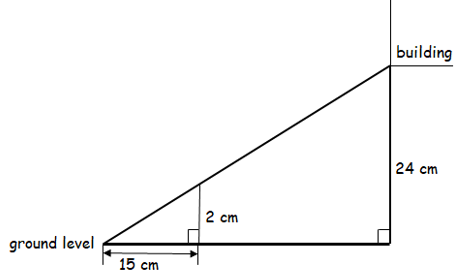
Solution :
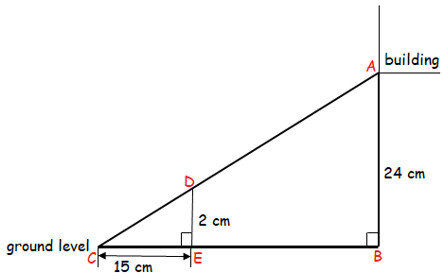
In ∆DEC and ∆ABC,
<DCE = <ACB (A)
<DEC = <ABC (A)
Using AA theorem, the above triangles
∆DEC ~ ∆ABC
DE/AB = CD/CA = CE/BC
DE/AB = CE/BC
Let BE = x, then BC = 15+x
2/24 = 15/(15+x)
1/12 = 15/(15+x)
15+x = 15(12)
15+x = 180
x = 165
BC = 165+15 ==> 180 cm
Length of base of ramp = √(1802+242)
= √(32400+576)
= √32976
= 181.59 cm
Approximately 1.81 m.
So, length of the base of ramp is 1.81 m.
Example 2 :
A boy who is 1.6 m tall casts a 2.4 m shadow when he stands 8.1 m from the base of an electric light pole. How high above the ground is the light globe ?
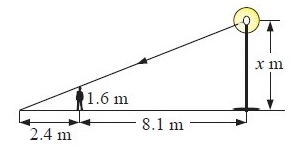
Solution :
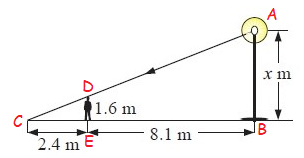
In ∆DEC and ∆ABC,
<DCE = <ACB (A)
<DEC = <ABC (A)
Using AA theorem, the above triangles
∆DEC ~ ∆ABC
DE/AB = CD/CA = CE/BC
DE/AB = CE/BC
1.6/x = 2.4/(2.4+8.1)
1.6/x = 2.4/10.5
1.6(10.5) = 2.4x
x = 16.8/2.4
x = 7
So, height of the light globe is 7 m.
Example 3 :
A piece of timber leaning against a wall, just touches the top of a fence, as shown. Find how far up the wall the timber reaches.
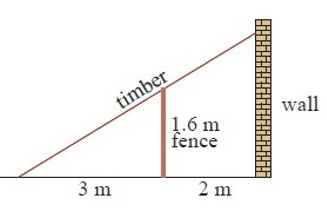
Solution :
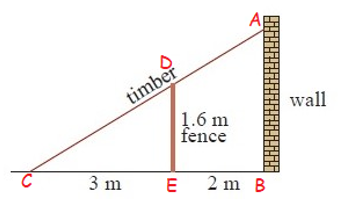
In ∆DEC and ∆ABC,
<DCE = <ACB (A)
<DEC = <ABC (A)
Using AA theorem, the above triangles
∆DEC ~ ∆ABC
DE/AB = CD/CA = CE/BC
DE/AB = CE/BC
1.6/AB = 3/(3+2)
1.6/AB = 3/5
1.6(5) = 3AB
AB = 8/3
AB = 2.66 m
At 2.66 m above the timber reaches the wall.
Example 4 :
At the same time as the shadow cast by a vertical 30 cm long ruler is 45 cm long, Rafael’s shadow is 264 cm long.
a) Draw a fully labelled sketch of the situation.
b) Find Rafael’s height ?
Solution :
(a)
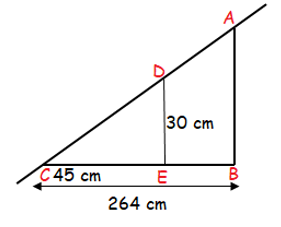
In ∆DEC and ∆ABC,
<DCE = <ACB (A)
<DEC = <ABC (A)
Using AA theorem, the above triangles
∆DEC ~ ∆ABC
(b) Rafael’s height AB = x m,
DE = 30 cm, BC = 264 cm and EC = 45 cm
Then, DE/AB = EC/BC
30/x = 45/264
45x = 7920
x = 7920/45
x = 176 cm
x = 176/100 m
x = 1.76 m
So, Rafael’s height is 1.76 m
Example 5 :
A 3.5 m ladder leans on a 2.4 m high fence. One end is on the ground and the other end touches a vertical wall 2.9 m from the ground. How far is the bottom of the ladder from the fence ?
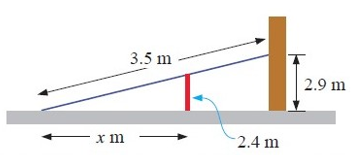
Solution :
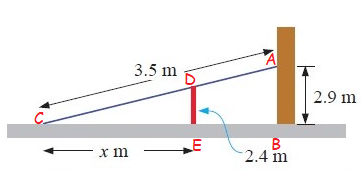
∆DEC ~ ∆ABC using AA theorem.
In ∆ABC,
AB = 2.9 m, AC = 3.5 m and CE = x cm
By using Pythagorean theorem,
AC2 = AB2+BC2
(3.5)2 = (2.9)2+BC2
BC2 = 12.25 - 8.41
BC2 = 3.84
BC = 1.95
DE = 2.4 cm
In similar triangles corresponding sides will be in same ratio.
Then, DE/AB = EC/BC
2.4/2.9 = x/1.95
2.9x = 4.68
x = 1.62 m
So, the bottom of the ladder from the fence is ≈ 1.62 m
Example 6 :
Two surveyors estimate the height of a nearby mill. One stands 5 m away from the other on horizontal ground holding a 3 m stick vertically. The other surveyor finds a “line of sight” to the top of the hill, and observes this line passes the vertical stick at 2.4 m. They measures the distance from the stick to the top of the hill to be 1500 m using laser equipment. How high, correct to the nearest meter, is their estimate of the height of the hill ?
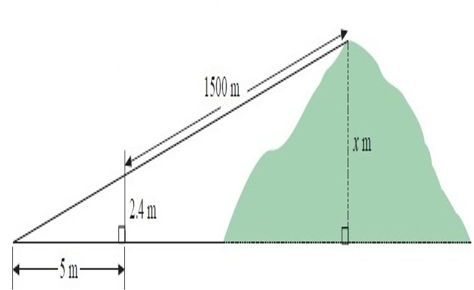
Solution :
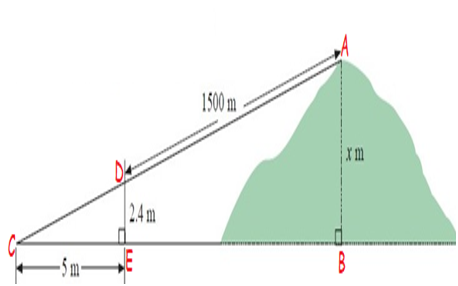
In ∆DEC,
DE = 2.4 m, EC = 5 m, AB = x cm
∆DEC ~ ∆ABC using AA theorem.
CD/AC = CE/BC = DE/AB
CD2 = CE2+DE2
CD2 = 52+(2.4)2
CD2 = 25+5.76
CD2 = 30.76
CD = 5.5
CD/CA = DE/AB = CE/BC
5.5/1505.5 = 2.4/x = 5/(5+BE)
5.5/1505.5 = 2.4/x
5.5x = 2.4(1505.5)
x = 3613.2/5.5
x = 656
So, the height of the hill is ≈ 656 m.
Example 7 :
Find the width of the canyon.
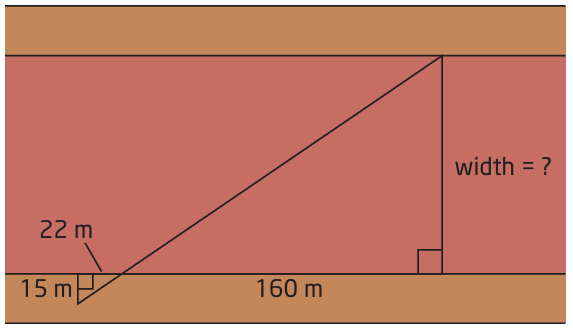
Solution :
Considering the triangles,
- Vertical opposite angles are equal.
- In both triangles, we have right angle.
Width / 15 = 160/22
Doing cross multiplication, we get
22 (width) = 160(15)
Width = 2400/22
Width = 109 m
The required width is 109 m.
Example 8 :
Use the dimensions of the surveyors’ triangles to find the width of the river, to the nearest metre.
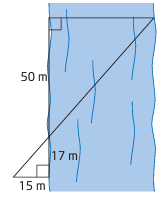
Solution :
Considering the triangles,
- Vertical opposite angles are equal.
- In both triangles, we have right angle.
Width / 15 = 50/17
Doing cross multiplication, we get
17 (width) = 50(15)
Width = 750/17
= 44.11 m
Example 9 :
In a diagram triangles ABC and EFG, AB = 12, EF = 30, BC = x and FG = 2x + 11. What is the value of x ?
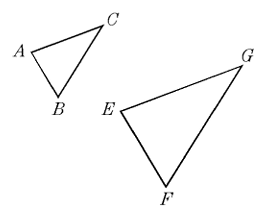
Solution :
AB/EF = BC/FG = AC/EG
12/30 = x/(2x + 11)
12(2x + 11) = 30x
24x + 132 = 30x
132 = 30x - 24x
132 = 6x
x = 132/6
x = 22
So, the value of x is 22.
Example 10 :
Two neighboring houses are located at A and B, near a straight section of a rural road, RD. The electric company plans to place a pole, P, at the roadside and connect wires from the pole to the two houses. How far from point R should the pole be located so that the minimum length of wire is needed?
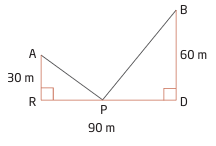
Solution :
Let RP = x, then PD = 90 - x
AR/BD = RP/PD
30/60 = x/(90 - x)
30(90 - x) = 60x
2700 - 30x = 60x
2700 = 60x + 30x
2700 = 90x
x = 2700/90
x = 30
Kindly mail your feedback to v4formath@gmail.com
We always appreciate your feedback.
©All rights reserved. onlinemath4all.com
Recent Articles
-
Digital SAT Math Problems and Solutions (Part - 150)
Apr 25, 25 11:46 AM
Digital SAT Math Problems and Solutions (Part - 150) -
AP Calculus AB Problems with Solutions (Part - 19)
Apr 24, 25 11:10 PM
AP Calculus AB Problems with Solutions (Part - 19) -
AP Calculus AB Problems with Solutions (Part - 18)
Apr 24, 25 11:06 PM
AP Calculus AB Problems with Solutions (Part - 18)
